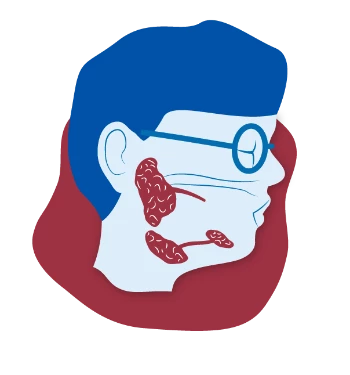What causes excessive drooling in a child?

- Understanding Drooling
12/01/2024
2 min

Excessive drooling, also known as sialorrhoea in the UK and sialorrhea in the US, is the unintentional loss of saliva from the mouth and can be distressing for children and their families, especially those aged four and above.
Understanding its causes and treatment options is important in improving quality of life.
The severity of drooling can vary from one child to another, too. For instance, a child struggling with head control might experience more obvious effects than a child with limited lip movement. Healthcare professionals will measure how often the drooling occurs, how much watering of the mouth there is and to what extent it’s causing discomfort or interfering with your child’s daily activities.
Every situation is unique so treatment will be tailored to each patient.
In more severe cases, children may wet their clothes, hands, and other objects with excess saliva. In these instances, a specialist may recommend treatment. However, there are several options available, including non-invasive and non-medicated treatments:
Read our helpful content on the assessment and management of sialorrhoea, or consider discussing it with your child’s healthcare professional if it’s causing discomfort or impacting daily life.
GB-CPL-061-066
January 2024
Back to BlogsUnderstanding its causes and treatment options is important in improving quality of life.
Causes of excessive drooling
Excessive drooling in children can result from medical conditions, developmental difficulties or medication. Here, we focus on the most common causes, often associated with neurological conditions in children:Difficulty swallowing
Problems with swallowing, also known as dysphagia, can cause saliva build-up and drooling. Lacking the sensation of saliva build-up is another cause.Poor mouth control
Good reflexes and mouth control are key to swallowing, so children who struggle with these may suffer from excessive drooling. Speech development issues and even overbite are other causes linked to poor mouth control.Poor posture
Children who have difficulty with their posture and head movement can struggle to keep saliva inside their mouths. Hunched shoulders and leaning forward with the head and neck can make swallowing difficult, which in turn leads to drooling.Ear, nose and throat
A child with large tonsils is likely to breathe through their mouth predominantly. If their mouth is always open, they are more likely to drool. In these cases, an ear, nose and throat (ENT) specialist may refer them for surgery to remove the tonsils. ENT specialists can also look for other obstructions to the airways, such as adenoids, which are small lumps of tissue at the back of the throat. Surgery may be required to remove enlarged adenoids to help a child breathe through their nose.Medication
Certain medications, such as those used to treat epilepsy, can cause excessive salivation and, in turn, drooling.Varying severity
Understanding the cause and severity of drooling is key to effective treatment. Healthcare professionals will try to identify the cause to determine suitable methods of managing the condition.The severity of drooling can vary from one child to another, too. For instance, a child struggling with head control might experience more obvious effects than a child with limited lip movement. Healthcare professionals will measure how often the drooling occurs, how much watering of the mouth there is and to what extent it’s causing discomfort or interfering with your child’s daily activities.
Every situation is unique so treatment will be tailored to each patient.
Available treatment options
Mild to moderate cases of excessive drooling normally show through wet lips and chin. These cases may not require treatment.In more severe cases, children may wet their clothes, hands, and other objects with excess saliva. In these instances, a specialist may recommend treatment. However, there are several options available, including non-invasive and non-medicated treatments:
Conservative management
Improving posture, reviewing medications or regular dental checkups are more conservative choices. Behavioural techniques can also help a child recognise and respond to the feeling of drooling.Mouth control exercises
Lip, tongue and swallowing control can be improved by oral exercises, allowing for more effective saliva management. A retainer-type mouth appliance is another option.Medication
If a child struggles with the concentration required for behavioural treatment or their difficulty with mouth control is too severe, medication may be more effective. Tablets, liquids, injections and skin patches can reduce saliva, and therefore reduce drooling.Surgery
In the most severe cases, non-surgical treatments may not be effective. A specialist may consider surgery on the salivary glands, which directs saliva towards the throat rather than the front of the mouth. Another potential option is partially removing the salivary glands to reduce saliva production.Understanding your child and their drooling
Understanding the different causes of excessive drooling is important in identifying suitable treatments for your child.Read our helpful content on the assessment and management of sialorrhoea, or consider discussing it with your child’s healthcare professional if it’s causing discomfort or impacting daily life.
GB-CPL-061-066
January 2024
Related Blogs

- Understanding Drooling
Sialorrhoea is the unintentional loss of saliva from the mouth. From lung infections and skin irritation to social isolation and bullying, excessive drooling (sialorrhoea) impacts physical and emotional well-being, particularly in children aged four and above.
Read More12/01/2024
3 min
